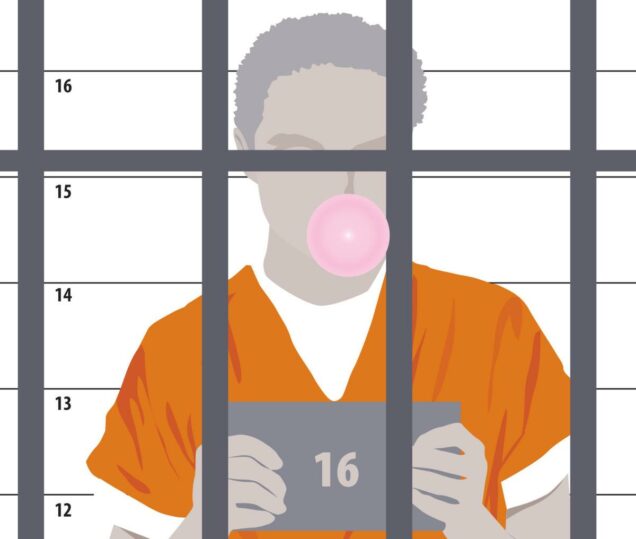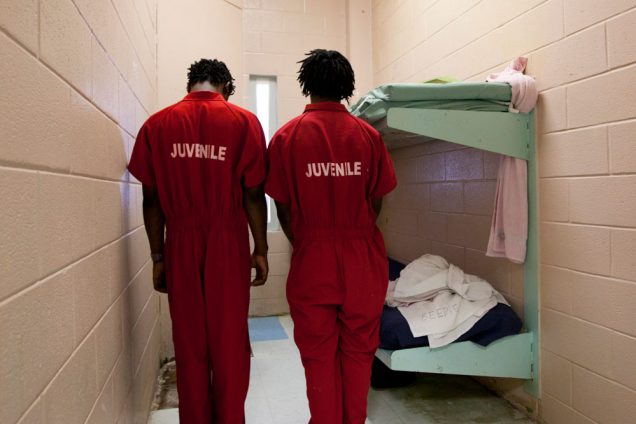Tagged: juvenile justice
Raise the Age: An Evidence-Based Approach to Juvenile Justice Reform
For a large portion of America’s youth, the 1990s marked the end of juvenile justice. Blinded by fear and captivated by rumors of a “superpredator” uprising, legislatures across the country decided to “Get Tough” on crime. This meant decreasing rehabilitation efforts, increasing punitive repercussions and transferring increasing numbers of youth to adult criminal courts and adult correctional facilities. In effect, “Get Tough” legislation has lowered the legal age of criminal responsibility.
Just under 15,000 individuals under the age of 18 were held in adult jails and state prisons during the 1990s. As crime rates decreased and the “superpredator” hysteria waned, that number decreased sharply, but there are still upwards of 4,000 juveniles being held in adult jails and prisons as of 2018. As well, Emerging Adults, individuals 18–25 years of age, are held responsibility for a disproportionate amount of criminal activity in the United States. Making up only 10% of the total population, Emerging Adults account for almost 30% of criminal arrests and 21% of the adult prison population.
There is little dispute that America’s youth is being held legally responsible for a disturbing amount of crime. The question facing legislatures today is to what extent are these individuals actually culpable for their crimes and whether the adult justice system is the appropriate forum for addressing that culpability.
“Get Tough” Approach
The “Get Tough” movement was largely founded on the premise of the now debunked theory of the “superpredator” promulgated by social and political scientists in the early 1990s. In 1996, Princeton Professor and Criminologist John J. DiIulio Jr. co-authored a book on “the war on crime and drugs”, writing:
[A] new generation of street criminals is upon us — the youngest, biggest and baddest generation any society has ever known.
America is now home to thickening ranks of juvenile ‘superpredators’ — radically impulsive, brutally remorseless youngsters, including ever more preteenage boys, who murder, assault, rape, rob, burglarize, deal deadly drugs, join gun-toting gangs and create serious communal disorders.’
Given that “[the] superpredator is a young juvenile criminal who is so impulsive, so remorseless, that he can kill, rape, maim, without giving it a second thought,” the logical solution to the impending “hordes of depraved teenagers” was imprisonment. Juveniles without a conscience were considered incapable of rehabilitation, and lawmakers were pushed to focus on the punishment and prevention of youth crime.
Scientific & Constitutional Review of “Get Tough”
Support for increased and prolonged incarceration relies heavily on the theory that severe punishment will deter crime. The threat of incarceration is thought to deter the general public from acting reckless or dangerous, while punishment “chastens” the individual to deter future criminal behavior. But both general deterrence and the “chastening effect” fall short of achieving their goals.
General Deterrence
In 2005, the Supreme Court began crediting scientific advances in adolescent neuro-psychology and proscribed the use of capital punishment and mandatory life without parole sentences for juveniles. In Roper v. Simmons, Justice Kennedy opined:
[A] lack of maturity and an underdeveloped sense of responsibility are found in youth more often than in adults and are more understandable among the young. These qualities often result in impetuous and ill-considered actions and decision
Once the diminished culpability of juveniles is recognized, it is evident that the penological justifications for the death penalty apply to them with lesser force than to adults. We have held there are two distinct social purposes served by the death penalty: “ ‘retribution and deterrence of capital crimes by prospective offenders.’ ” Atkins, 536 U. S., at 319 (quoting Gregg v. Georgia, 428 U. S. 153, 183 (1976)
[T]he absence of evidence of deterrent effect is of special concern because the same characteristics that render juveniles less culpable than adults suggest as well that juveniles will be less susceptible to deterrence. In particular, as the plurality observed in Thompson, “[t]he likelihood that the teenage offender has made the kind of cost-benefit analysis that attaches any weight to the possibility of execution is so remote as to be virtually nonexistent.” 487 U. S., at 837.
For general deterrence to be effective, a juvenile must be capable of rationally assessing their actions before they act. As Justice Kennedy noted when he declared juveniles ineligible for the death penalty, juveniles act impulsively and irrationally. Therefore, the threat of prosecution in criminal court is unlikely to deter juveniles from criminal action.
The Chastening Effect
The chastening effect follows the age-old notion that punishment teaches a lesson. The idea that delinquent youth must be taught a lesson was abundant during the “superpredator” scare of the 1990s. The problem is, the evidence does not support that theory. In fact, the evidence suggests the contrary. Youth in the adult criminal justice system are more likely to re-offend upon release.
A Juvenile Recidivism Study in Vermont that compared 16 and 17 year old offenders charged with similar offenses in the juvenile and adult courts. The study found “[t]he three-year recidivism rate for juveniles adjudicated in the Family Division was 25%, compared to a 47% three-year recidivism rate for juveniles convicted in the Criminal Division.” Recidivism can often be attributed to higher levels of isolation and victimization experienced by you in adult correctional facilities, as well as the criminal culture perpetuated by other inmates.
Furthermore, recent studies have found that “the criminal justice system — and the accompanying violence, stress and isolation [ ] that come with being incarcerated — can interfere with brain development in adolescents and children.” A Harvard study on emerging adults concluded:
Higher recidivism rates among emerging adults are not surprising. Justice-involved emerging adults have been victims of violent crime and have experienced emotional and physical trauma at a higher rate than any other population. Exposure to toxic environments such as adult jails and prisons further traumatizes justice involved emerging adults, making them more vulnerable to negative influence, and as a result, increases recidivism among this group. Tailoring the justice system’s response to emerging adults’ developmental needs can reverse this cycle of crime and improve public safety.
“Diminished Culpability”
The Supreme Court has established precedent for amending existing law to meet the “evolving standards of decency,” and decency requires legislatures to re-evaluate the age of criminal responsibility.
The Brain
Much of the research cited by the Supreme Court back in the early 2000s found that those traits the Court ruled “diminished culpability” are present even in late adolescence (age 17, 18, and 19). However, as of January 11, 2019, 17 states still prosecute adolescence age 17, 18, and 19 as adults. An additional 5 states allow the prosecution of juveniles as young as 16 in adult court.
Recent advances in developmental brain science has shown that the human brain is still developing well in to their 20s. The well established consensus in the scientific community is that the brain functioning of a juvenile is not comparable to that of an adults until at least age 25. Particularly relevant to diminished culpability is the continuing development of the prefrontal lobe. The prefrontal lobe is responsible for executive functions such as risk assessment, planning, self-evaluation, goal-setting, and the regulation of our emotions.
Emerging Adults
Psychologist Jeffrey Arnett coined the term “Emerging Adult” in 2000. In the context of criminal justice, emerging adults refers to individuals having attained 18 years of age up to 25 years of age. This age group should be especially important to legislatures because emerging adults have higher rates of incarceration and recidivism. A national study of 30 states revealed that approximately 78% percent of emerging adults released in 2005 were re-arrested within 3 years. Whereas approximately 73% percent of those 25 to 29 and 63% percent of those 40 and older were rearrested within 3 years of release. The study found the pattern held true 5 years after release, and under 30% of those new arrests were violent.
Higher recidivism rates among emerging adults can be attributed Justice-involved emerging adults have been victims of violent crime and have experienced emotional and physical trauma at a higher rate than any other population. Exposure to toxic environments such as adult jails and prisons further traumatizes justiceinvolved emerging adults, making them more vulnerable to negative influence, and as a result, increases recidivism among this group. Tailoring the justice system’s response to emerging adults’ developmental needs can reverse this cycle of crime and improve public safety. Conversely, when emerging adults are provided with age-appropriate programing, the recidivism rate drops dramatically.
Moreover, a large portion of offenders, even violent offenders, age-out of crime. On average, property crimes peak at age 16 and violent crimes at age 17. According to a Justice Policy Institute report,
The evidence is clear that most young people will desist from criminal behavior without intensive justice-system involvement. By better addressing the unique needs and behavior of young adults, justice systems can develop responses that limit the risk youth pose to themselves and others during this transitory life stage.
Raise the Age
The “Raise the Age” campaign advocates for legislation that raises the maximum age of juvenile jurisdiction. Raising that age allows more developmentally underdeveloped individuals to be tried in a juvenile or family court. These courts are considerably more focused on education and rehabilitation that adult criminal courts.
In 2013, Massachusetts raised the age from 17 to 18, and juvenile crime has declined by 34%. Also on the decline in Massachusetts is the number of youth in juvenile facilities. Massachusetts success in raising the age can be attributed to “improving community-based responses and using cost-effective and developmentally appropriate approaches.”
Most states now include 17-year-olds in juvenile jurisdiction, but only one state – Vermont – has raised the age above 18 in conformance with advances in developmental studies of the brain.
Modern science tells us that emerging adults take more risks, have less self-control and are less culpable of their crimes. An evidence-based approach to legislation would demand a re-evaluation of emerging adults in the criminal justice system and the enactment of age-appropriate reforms.
 Melissa Mayfield anticipates graduating from Boston University School of Law in May 2021.
Melissa Mayfield anticipates graduating from Boston University School of Law in May 2021.
At Last: New York Remembers the Adolescence of its Juveniles Offenders
On April 10th of this year, New York became the 49th state to pass legislation ending the treatment of 16 and 17 year olds as adults in the criminal justice system. Assembly Speaker Carl Heastie touted the bill’s passage as a “tremendous victory for communities across the state that have endured senseless tragedies and called on the Legislature to deliver a justice system that recognizes the difference between a child and an adult.” While New York was one of only two states to continue to prosecute these juveniles as adults, the Assembly had been working to pass similar legislation for over 12 years.
The prosecution of juveniles in adult criminal court has been proven to have serious lifelong consequences. The human brain is not fully developed until the age of 25, before juveniles mature they often lack impulse control and the ability to anticipate and understand the consequences of their actions. Adolescents tend to be receptive to interventions, responding well to juvenile treatment and services by learning to make responsible choices and ending delinquent behavior. Studies show that youth offenders prosecuted and sentenced in the adult criminal justice system are 34% more likely to be re-arrested than juveniles who are charged in the youth justice system. In addition to the impact that the adult criminal justice system has on the juvenile’s future behavior, youth offenders detained in adult prisons are more likely to be beaten by staff, sexually assaulted, 50% more likely to be attacked with a weapon, and are 36 times more likely to commit suicide while detained.
New York’s Raise the Age bill has multiple facets. Under the new legislation, 16 and 17 year olds accused of misdemeanors will be sent to Family Court. Felony cases, however, will remain in adult criminal court in a new section called the “youth part,” which will house judges trained in Family Court law. After 30 days, 16 and 17 year olds charged with nonviolent felonies will be sent to Family Court unless a district attorney has proven that there are “extraordinary circumstances” that warrant the juvenile’s retention in the adult criminal system. The term “extraordinary circumstances” is undefined in the new law, although Alphonso David, the governor’s counsel, has stated his belief that it will be widely understood to mean “remarkable, exceptional, amazing, astounding, incredible.” Those juveniles charged with violent felonies may also be transferred to Family Court if they pass a three-part test. The test balances whether the victim sustained significant physical injury, the accused used a weapon, and whether the perpetrator engaged in criminal sexual conduct.
The bill also changes the rules regarding the detention of juveniles. After the horrible details surrounding the arrest and detention of Kalief Browder became public knowledge, there was a powerful push for juvenile detention reform. Kalief Browder was a 16-year-old kid living in the Bronx in 2010 when he was arrested for allegedly stealing a backpack. Mr. Browder never faltered in his denial of guilt, despite this he was detained on Rikers Island for 3 years, two of which were spent in solitary confinement, without charges. The time spent on Rikers, replete with assaults by guards and inmates, solitary confinement, and awaiting a trial that never came affected his mental state in ways that would be expected of anyone, let alone a teenager. Two years after his release from Rikers Island, Mr. Browder committed suicide and became a household name reflecting the horrors of the criminal justice system for the youth of New York. The Raise the Age legislation, signed by Governor Cuomo with Kalief Browder’s brother, Akeem, looking on, is an attempt to prevent a tragedy such as this from ever occurring again. Beginning October 1st, 2018, offenders under 18 will no longer be held at Rikers Island and those 17 years old will no longer be held in county jails, a similar rule will be enforced for those under 18 a year later.
Despite victory for proponents of the bill, many are disappointed in the newly passed legislation. Last year alone, 3,445 juveniles were charged with violent felonies and therefore would still have been prosecuted in the “youth part” of the adult criminal system. Those adolescents will continue to receive lengthy prison stays and lifetime criminal records. Kevin Parker, a State Senator from Brooklyn, voiced his consternation at how complicated this bill became, “[a]ll we had to simply do is say that we’re going to take 16- and 17-year-olds and we’re going to treat them just like 15-year-olds. That’s all we had to do, right? All we had to do. And we messed that up.”
While New York’s bill may not be perfect, it will give many young offenders an opportunity to learn from their mistakes and become law-abiding adults. Over 17,000 adolescents aged 16 and 17 are accused of misdemeanors each year, under the new bill these charges will be heard in family court where judges are trained to know what is best for the adolescent offender and have more access to social services that may help rehabilitate rather than strictly penalize this vulnerable community. The change in detention facility alone will mean the difference between a mistake and lifetime behavior for many, for some it will mean the difference between life and death. A staunch supporter of the original bill, Senator Diane Savino of Staten Island, made it clear that the fight to raise the age for adult criminal liability is far from over. “For those who don’t think it goes far enough, I will remind you: We are not dropping off the end of the earth tonight. Laws are made to amend them.”
 Alexandra Raymond is from Vergennes, Vermont and graduated from New York University in 2014 with a B.A. in Sociology and Law & Society. She is expected to earn her Juris Doctor from Boston University School of Law in 2018. Alexandra will be working for an investment management firm in Boston during the summer of 2017 and will then spend her next semester studying international law at Leiden Law School in the Netherlands. Upon graduation, Alexandra hopes to pursue a career that allows her to explore her interests in business, social justice, and international law.
Alexandra Raymond is from Vergennes, Vermont and graduated from New York University in 2014 with a B.A. in Sociology and Law & Society. She is expected to earn her Juris Doctor from Boston University School of Law in 2018. Alexandra will be working for an investment management firm in Boston during the summer of 2017 and will then spend her next semester studying international law at Leiden Law School in the Netherlands. Upon graduation, Alexandra hopes to pursue a career that allows her to explore her interests in business, social justice, and international law.




